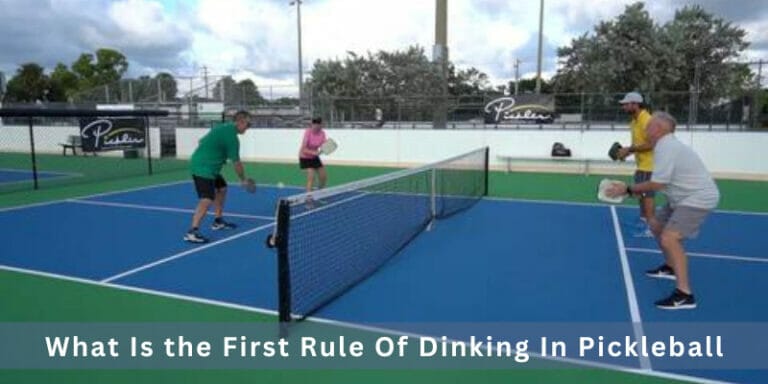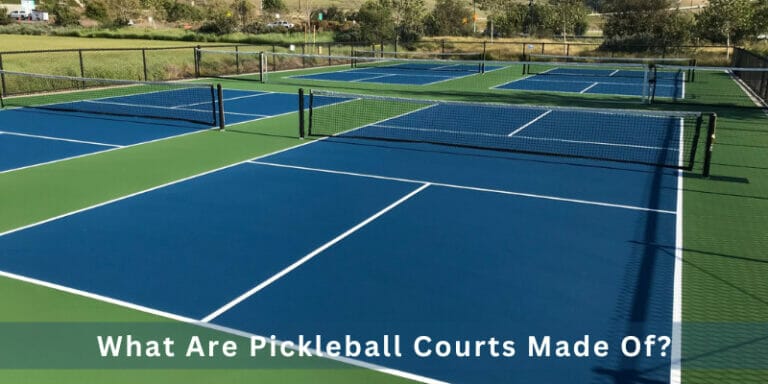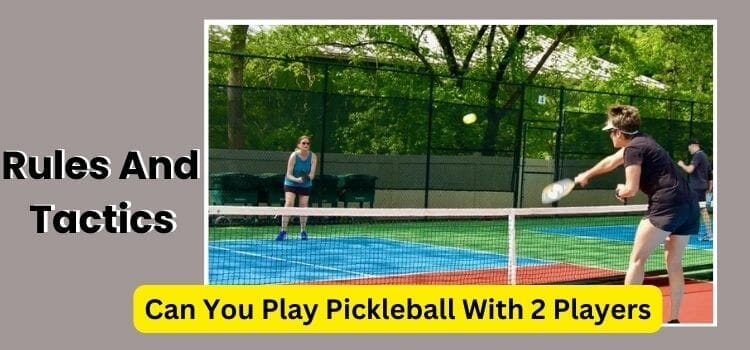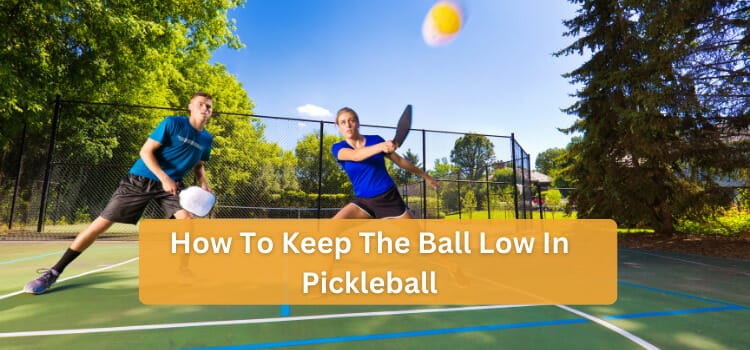How To Make a Pickleball Court | Comprehensive Guide
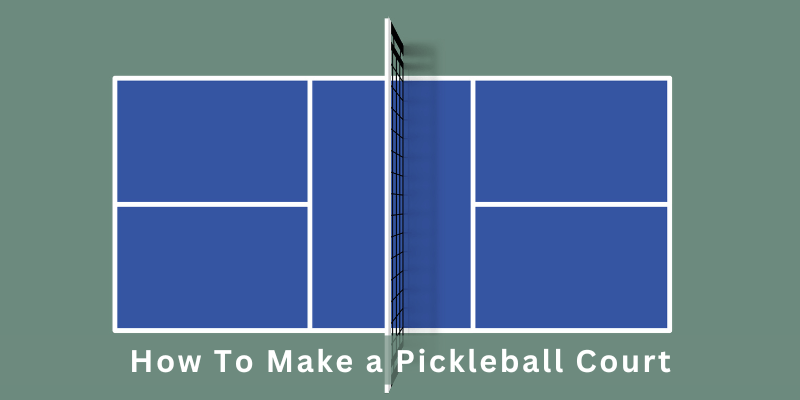
You must wonder about the secret to creating the ultimate pickleball court and impressing your friends and family.
Here you go,
To make a pickleball court, you’ll need a flat surface, preferably 60′ x 30′, with low net and boundary lines. Use non-slip paint or tape for markings. Install a net with a height of 36″ at the ends and 34″ in the middle.
To make a DIY court, you’ll need to measure and mark the court sizes, clear the area, and lay down the court surface. My personal experience was good, and it’s a fun and easy project for any DIY enthusiast.
In this article, we will provide a step-by-step guide on how to make a pickleball court.
Let’s get cracking,
What is a Pickleball Court?
A pickleball court is a playing surface used for the sport of pickleball. It is typically rectangular and measures 20 feet wide and 44 feet long.
It is divided in half by a net 36 inches high at the center and 34 inches high at the posts. The court is also marked with boundary lines that define the playing area.
The surface of a pickleball court can be made from various materials, including concrete, asphalt, or manufactured materials.
It is usually colored in bright, contrasting colors to make seeing the lines and the ball easier. To ensure safe and consistent play, the surface should be smooth and free from bumps or cracks.
It can be found in various locations, including public parks, community centers, and private clubs.
They are popular among players of all ages and skill levels and can be used for recreational and competitive play.
Whether you are a beginner or a seasoned pro, a pickleball court provides a fun and challenging environment to improve your game and enjoy the sport.
Step-by-Step guide on how to make a pickleball court
Here is a fantastic guide which I elaborate in the step-by-step guide on how to make a pickleball court to make easy for your project:
Step 1. Choosing the Location:
The first step in making a pickleball court is choosing a location. Look for a flat and level area with plenty of space.
The standard size of a pickleball court is 20 feet wide by 44 feet long. Assure no obstructions like trees, rocks, or other objects are on the surface.
Also, keep in mind that the area should be easily accessible and should not be too close to your neighbors.
Step 2: Preparing the Ground:
Once you’ve chosen the location, it’s time to prepare the ground. You must remove any grass, rocks, or debris from the area.
Use a sod cutter or a shovel to remove the top layer of grass or sod, and level the ground as much as possible. Ensure the surface is firm and free of bumps or hollows.
Step 3: Marking and Measuring:
Successive, you’ll need to measure and mark the area. Use measuring tape or a long rope to measure and mark out the 20-foot by 44-foot area.
You can use stakes or cones to mark the corners and lines of the court. Double-check that everything is properly measured and leveled.
Step 4: Building the Court:
Once the area is marked out, it’s time to build the court. You can use either concrete, asphalt, or compacted gravel to create a solid foundation.
You may need to hire a professional contractor for the concrete and asphalt option. If you install the court yourself, follow the manufacturer’s instructions carefully.
It’s also important to make sure the foundation is level and smooth.
Step 5: Installing the Net Posts:
After laying the foundation, it’s time to install the net posts. You can use metal or wooden posts, and they should be placed at a distance of 22 feet from each other.
Make sure that they are securely anchored to the ground and level.
Step 6: Maintaining the Court:
To maintain your pickleball court, you’ll need to regularly sweep or blow off any debris like leaves, dirt, or sand.
You can also use a pressure washer to clean the surface. It’s important to regularly inspect the court for any signs of damage or wear and tear.
Painting the Lines:
Once the court is built and maintained, it’s time to paint the lines. You can use either paint or tape to mark the boundaries and centerline of the court. Make sure that the lines are straight and even.
Caring for Your Court:
Finally, it’s important to care for them properly. Avoid using harsh chemicals or abrasive cleaning products that could damage the surface. Covering it to protect it from the elements when not in use is also a good idea.
Materials And Tools for Marking pickleball court
The major part is material: anything you try to make, you should know which material and size are needed.
So, here are the materials you’ll need to mark a pickleball court
Material 1: Paint
It is suitable for outdoor use and can adhere to asphalt or concrete surfaces. It’s recommended to use a bright color like white or yellow for the lines and boundaries of the court.
Material 2: Measuring Tape
The measuring tape to ensure the court is the correct size and dimensions. The official size of a pickleball court is 20 feet wide by 44 feet long.
Material 3: Chalk
It can be used to mark out the court before you start painting. It’s a good idea to double-check the court’s dimensions with chalk before painting to ensure everything is correct.
Material 4: Paint Roller:
It can be used to apply the paint to the court. A roller with a long handle is recommended to make reaching all parts of the court easier.
Material 5: Paintbrush
You’ll need a paint brush for touch-ups and to paint the court’s edges.
Material 6: Painter’s Tape
It can be used to create straight lines and sharp edges. This can help make the court look more professional and well-defined.
Material 7:Stencil
Stencils can guide your painting, ensuring your lines are straight and even. They are available for purchase online or at your local sporting goods store.
That’s it! With these materials, you should be able to mark a pickleball court that is the correct size and looks great.
Expert tips for Maintaining care of the Pickleball Court
As we know, proper care and maintenance is mandatory to keep thing long-lasting so, you can keep it in top condition, providing a safe and enjoyable playing experience for years to come.
Tip 1: Sweep the Court Regularly
Dirt, debris, and leaves can accumulate on it, making it slippery and dangerous for players. Use a broom or leaf blower to sweep the court before and after each game.
Tip 2: Remove Stains and Marks
Use a mild detergent and water to clean any stains or marks. Avoid harsh chemicals or abrasive cleaners, as they can damage the surface.
Tip 3: Repair Cracks and Damage
Over time, the court’s surface may develop cracks or other damage. Repair cracks or holes with a patching compound designed specifically for pickleball courts.
Tip 4: Keep the Net Tight
The net should be kept tight and at the correct height (36 inches at the center of the court). Check the net regularly and adjust it as needed.
Tip 5: Trim Surrounding Vegetation
Overhanging trees and bushes can drop leaves, and twigs, and remain on the court. Trim any vegetation around the court to prevent this from happening.
Tip 6: Maintain Proper Drainage
It is essential for preventing standing water, which can damage the surface and create unsafe playing conditions.
Ensure it has proper drainage and clear any debris from the drainage system regularly.
Tip 7: Cover the Court When Not in Use
Cover it with a high-quality cover when it is not in use to protect it from the elements. This will help prevent damage from sun, rain, and wind.
How much cost is required to make a pickleball court
The cost is depending on various factors such as the location, size, materials used, and labour costs.
Here’s a breakdown of the costs involved in the building:
Site preparation
Before building it, you may need to prepare the site by clearing the area and levelling the ground.
This can cost anywhere from $500 to $5,000, depending on the condition of the site.
Materials
The materials used typically include concrete, asphalt, or a specialised pickleball court surface.
These materials can range from $3 to $10 per square foot, with an average court size of 30 by 60 feet.
Fencing
You may need to install fencing around it to keep the ball from bouncing out of bounds. The range can range from $3,000 to $10,000, depending on the type of fence you choose and the size of the court.
Lighting
If you plan to use that night, you must install lighting. The range start from $2,000 to $10,000, depending on the type and number of lights you need.
Miscellaneous Costs
There may be additional costs for items such as net systems, line markings, and equipment storage. These costs can range from $500 to $5,000.
Prevalent, the total cost can range from $10,000 to $50,000 or more, depending on the above mentioned factors.
Getting a detailed quote from a contractor is important to get an accurate estimate for your specific situation.
How Long Does A Pickleball Court Surface Last?
It can last for several years, but the lifespan can vary depending on several factors. Here are some of the factors that can affect the longevity of a pickleball court surface:
Type of surface
It can be made of various materials such as concrete, asphalt, or acrylic. Each type has a different lifespan, with concrete being the most durable and long-lasting.
Quality of construction
The quality can also affect its lifespan. A well-constructed court with proper drainage and a level surface will last longer than a poorly constructed court.
Climate and weather conditions
Extreme weather conditions like heavy rain, snow, or high temperatures can have a significant impact on lifespan.Exposure to direct sunlight can cause the surface to fade and crack over time.
Frequency of use
The more frequently a court is used, the quicker the surface will wear down. They are used daily or for tournaments will likely need to be resurfaced more frequently than courts that are used less often.
So, the maintenance can last anywhere from 5 to 15 years or more, depending on the factors mentioned above. It’s important to regularly assess the condition of the court and address any issues.
Conclusion
Creating it can be a fun and rewarding project. Whether you’re building a permanent court in your backyard or setting up a temporary court for an event, the process can be straightforward and relatively simple.
With the right tools, materials, and a bit of planning, you can create a safe and functional court that provides hours of enjoyment for players of all skill levels.
Remember to follow any local regulations and safety guidelines to ensure that your court is up to code and ready for play. With a little effort, you can create a pickleball court that will be the envy of your friends and family.
FAQs
Can You Play Pickleball on A Tennis Court?
Yes, you can play it.In fact, many pickleball players use tennis courts as a makeshift option, although the lines and dimensions may not be ideal.
Can You Turn A Tennis Court Into A Pickleball Court?
Yes, you can turn a tennis court by adding proper court lines and adjusting the dimensions of the court.
What Makes A Good Pickleball Court?
It should have proper court dimensions, high-quality court surface material, clear court lines, and ample space around the court for player movement. It should also have appropriate lighting and equipment, such as net systems, paddles, and balls, for safe and enjoyable play.

